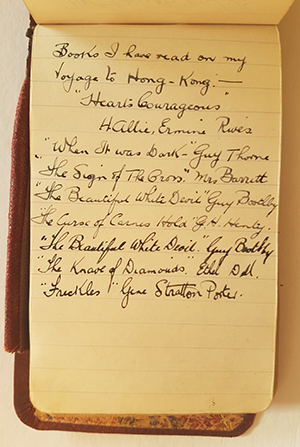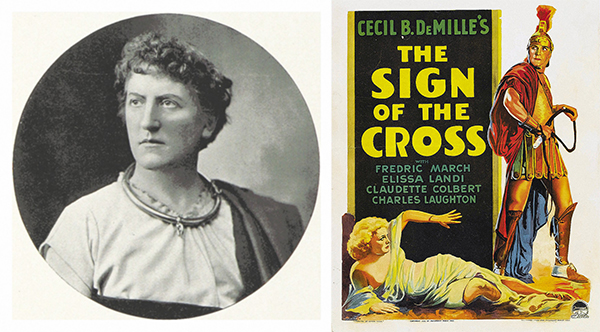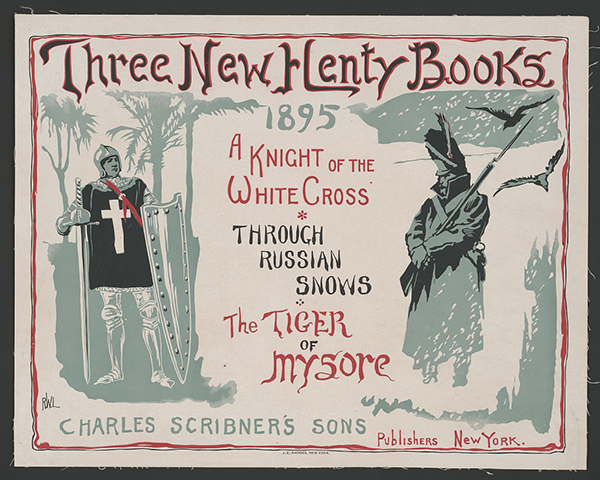Thrills, spills and chick-lit
Published in Features, Issue 6 (November/December 2016), Volume 24, World War IA FIRST WORLD WAR SOLDIER’S READING LIST
By Laurence Fenton
On 14 September 1914, James O’Donnell, an eighteen-year-old soldier from Carrick-on-Suir, Co. Tipperary, was injured while digging a trench near the small French town of Verneuil during the mayhem of the Battle of the Aisne. A German shell had landed close by, shattering the leg of another soldier and sending shrapnel into O’Donnell’s face and neck, a pocket-book stopping another piece from piercing his heart. A few moments later, he was struck by a bullet to the arm before being helped away to a temporary hospital.
Plenty of time to read
A sapper with the Royal Engineers, O’Donnell returned to Carrick for part of his recuperation; the front room of the family home on 8 Main Street was a general store that sold everything from cigarettes to crockery to seeds. That Christmas he received a small diary from his younger sister Molly, a diary now in the possession of his grand-nephew Jim Lynch in Wiltshire, England. O’Donnell, described by a local newspaper, the Waterford News, as a ‘very intelligent and modest and retiring young man’, did not return to the trenches, spending the remainder of the war at training camps and bases like Landguard Fort in Suffolk or on board ships like the SS Titan, which took him around Africa and Asia. It was a remarkably quiet life, for the most part, for a soldier in a time of war. There were certainly plenty of opportunities for reading. O’Donnell made a list in early 1918 of the seven books he read on the journey from Durban in South Africa to Hong Kong, beginning with Hallie Erminie Rives’s Hearts Courageous (1902), a romance played out against the backdrop of the American Revolution that included George Washington, Thomas Jefferson and Benjamin Franklin among its sprawling cast of characters, together with the strong-willed young heroine, Anne Tillotson, a ‘slender girl’ who, we learn in the first few pages, was ‘of that age when nature paints with her richest brush’ (i.e. eighteen), and a mysterious Frenchman, Louis Armand—or rather, as it turns out, the marquis de la Trouerie, a secret emissary from the French king—whom she will eventually marry after many adventures.

Above: O’Donnell’s early 1918 list of the seven books he read on the journey from Durban in South Africa to Hong Kong, beginning with Rives’s Hearts Courageous. (Jim Lynch)
The religious theme continued with Wilson Barrett’s The Sign of the Cross (1895), a historical play that bore a strong resemblance to Henryk Sienkiewicz’s novel Quo Vadis, which was released around the same time. One of the most famous theatrical personalities of the era, Barrett was an actor, writer, manager and producer who specialised in melodramas. Set in Nero’s Rome and ending with the Christian heroes—the Roman patrician Marcus Superbus and the beautiful young Mercia—sacrificing their lives in the lion’s den, The Sign of the Cross was the most successful of all his plays, running for long spells on both sides of the Atlantic through the 1890s. It was also adapted for film—again like Quo Vadis—by Cecil B. DeMille in 1932, starring Charles Laughton as Nero.
Capitalising on the success of the play, Barrett published a novelisation of The Sign of the Cross in 1897, and it is not clear which version O’Donnell read on board the SS Titan. There is no such confusion about the next book on his list, Guy Boothby’s The Beautiful White Devil (1896), a pure, unalloyed adventure novel following the exploits of a beguiling Robin Hood-esque female pirate around the South China Seas. Boothby was the popular Australian-born author of more than 50 books, thrillers and mysteries that focused in the main more on sensationalism than on tightly constructed plots. He was dismissed by critics but didn’t care. ‘I give the reading public what they want … In return my readers give me what I want,’ he stated haughtily, his royalties purchasing him a mansion near Bournemouth on the south coast of England.

Above: Wilson Barrett (left) c. 1899, one of the most famous theatrical personalities of the era. His historical play The Sign of the Cross (on O’Donnell’s list) was later adapted for film by Cecil B. DeMille in 1932 (right).
Jingoism
There were more thrills and spills with G.A. Henty’s The Curse of Carne’s Hold (1889). Its chief protagonist, Ronald Mervyn, is forced to leave England for South Africa under a cloud of suspicion in the early 1850s. Thrust into the Kaffir Wars—a series of conflicts between European settlers and African tribes now known as the Xhosa Wars—he rescues an English family from some of the ‘savages’; they in turn travel back to England to prove his innocence. Popularly known as ‘the Boy’s Own historian’, Henty was the author of more than 100 books, the majority of which revolved around young boys caught up in the midst of great historical events, be they the Crusades, the French Revolution or the American Civil War. A former war correspondent, he was also incredibly jingoistic when it came to the British Empire, military heroes like Marlborough, Wellington and Clive of India bestriding the pages of many of his works in celebratory prose.
The British Empire would also loom large in the work of Ethel M. Dell, the author of more than 30 novels set mainly in India or other exotic colonial possessions. The title O’Donnell read, The Knave of Diamonds (1913), a convoluted romance between a beautiful English lady caught in a loveless marriage and a brooding American interloper, was of a piece with Dell’s other books in theme and tone, even if the setting—England—was somewhat different. Its success secured Dell’s reputation as one of the most successful novelists of her time, a reputation established two years earlier with her best-selling début The Way of an Eagle. In later years, Dell’s frothy style would be satirised gently by P.G. Wodehouse. Her popularity, however, survived these barbs, at least for a while, with The Knave of Diamonds among a number of her novels republished in the 1970s as part of Barbara Cartland’s ‘Library of Love’.
O’Donnell’s reading list ended where it began: America. On this occasion, however, he was immersed in the Indiana swamps of Gene Stratton-Porter’s Freckles (1904) as opposed to the Virginia plantations of Hearts Courageous.
Although in large part a paean to the flora and fauna of the author’s beloved Limberlost Swamp, Freckles was also another romance, its chief protagonist an Irish-seeming youth with red hair and a face—as the title not-so-subtly indicates—full of freckles. The boy, an orphan known only as ‘Freckles’, is also missing his right hand, though this does not stop him from getting a job guarding timber at the Limberlost Swamp. He falls in love with a local girl, the ‘Swamp Angel’, but is badly injured in a fight with loggers trying to cut down some of the swamp’s priceless trees. By the end of the novel, Freckles discovers the truth about his parents, a young Irish lord and a clergyman’s daughter who ran away to America to marry but died in the fire that took his hand. He is, it turns out, an O’More from Ireland, heir to Dunderry House in County Clare. Freckles, however, does not return to Ireland, unable to leave either his beautiful Swamp Angel or the plants and animals of the Limberlost.
O’Donnell’s view?
O’Donnell did not record his thoughts on any of the books he read on the journey to Hong Kong, which is a shame. He was a well-educated man who visited libraries and art galleries in South Africa, and it would be interesting to know whether he read such escapist literature (which is what most of the books amounted to) to take his mind off the war or whether they genuinely reflected his literary tastes. Nor does he explain how he came across these particular books on the Indian Ocean, half a world away from his Tipperary home. Had he sought them out or just chanced upon them? Whatever the reasons, it seems likely that he enjoyed a good melodrama, particularly those with religious overtones. He came, of course, from a deeply Catholic society and was full of praise for the efforts of priests on the front line of the war when interviewed by the Waterford News while he recuperated in Carrick.

Above: An 1895 advertisement for three books by G.A. Henty, popularly known as ‘the Boy’s Own historian’. His The Curse of Carne’s Hold (1889) was on O’Donnell’s list.
Hints of a romantic temperament can also be discerned in his focus on the splendour of the German shells in the same interview—the very shells that maimed so many of his comrades and nearly killed him. ‘They present a weirdly beautiful sight as they pierce the darkness in a red line.’ His notes from South Africa, meanwhile, include descriptions of Table Mountain, among other sights, and he seems to have been far more inclined to drink fennel tea and eat grapes while soaking up a good view than to carouse in bar rooms. Briefly infatuated with a sixteen-year-old English girl called Mabel in Hong Kong in late 1919, he writes (pretty dull) poetry and fills his diary with hopes for their future, even attempting to arrange a transfer to Devonport, the large naval base in Plymouth, when the girl’s father, a colonial or army official of some sort, is sent there.
Questions that cannot be answered include whether or not O’Donnell agreed with the anti-Semitic sentiments in When It Was Dark. It’s certainly possible; casual anti-Semitism was far from uncommon in Ireland when he was growing up. It would also be interesting to know whether he shared G.A. Henty’s attachment to the British Empire or was more attracted to the passionate talk of ‘liberty’ in Hearts Courageous. The fact that he does not seem to have been attached to any of the myriad nationalist movements of the era and actually joined the British Army ten months before the outbreak of war, staying on for another few years after the war ended, suggests the former. Nevertheless, he was certainly conflicted about his position in the army by the time of the War of Independence, the murder of the mayor of Limerick, George Clancy, by RIC Auxiliaries in March 1921 forcing him to ask himself the deep questions with which many other Irish men in British uniforms were confronted during the tumultuous, often frighteningly violent years leading up to the creation of the Irish Free State. ‘My God, what ought I to do,’ he wrote from Aden, news of the murder travelling quickly across the world. ‘Should I still serve the bloody Govt. that permits its servants to carry out atrocities of this kind in my dear native land … I am terribly worried over these awful happenings & I pray to God that everything may soon be settled & that success may crown the efforts of our struggling people. A DIA SAOR ÉIRE.’
Laurence Fenton is a writer and editor living in Cork.
Read More:
Hallie Erminie Rives
When It Was Dark
FURTHER READING
T. Burnell, Irishmen in the Great War: reports from the Front 1914 (Barnsley, 2014).
















